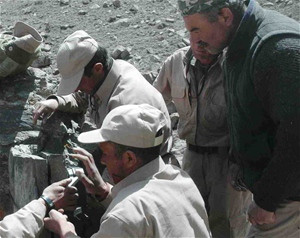
Kormal (top center) works with other rangers to set up a camera trap in the Wakhan. Under his leadership, they became the first Afghan community ranger team to successfully perform wildlife surveys without the assistance of foreign advisors, as well as th
Wildlife Conservation Society
USAID helps to establish the first ranger corps in Afghanistan.
4 MAY 2010 | WAKHAN CORRIDOR, BADAKHSHAN PROVINCE, AFGHANISTAN
Kormal, from northern Afghanistan’s Wakhan district, has always been an expert on endangered species. Just a few years ago, he was making a living for himself and his family by hunting rare snow leopards and lynx and selling their skins to fur traders.
When USAID, through its partner the Wildlife Conservation Society, began working to raise awareness about conservation in his district, Kormal’s interest was piqued. He was surprised when his village nominated him to participate in the new community conservation ranger program because he was a hunter. In fact, Kormal’s knowledge of the local mountains and wildlife made him a prime candidate. Over the course of a challenging training period, he developed strong leadership skills and became a dedicated conservationist.
Rangers are essential to successful management and protection of natural resources. In a country like Afghanistan, which has suffered three decades of war and subsequent environmental degradation, the ranger program is key to ensuring future protection of natural resources as well as the empowerment of local communities.
The USAID-supported community ranger program in Afghanistan has been developed to suit local conditions, but is modeled on international best practice. Communities recruit and select their own rangers through a transparent and competitive process. This empowers local government, generates jobs and income for rural communities, and provides a mechanism for local-level protection of resources.
Rangers form into village and community teams that are responsible for the protection and monitoring of natural resources and rangelands in their localities. Rangers who show particular skill and interest – such as Kormal – are identified and used as instructors to train newly recruited personnel.
Kormal hasn’t totally changed – he still traps snow leopards and other endangered species. But now he uses a camera, helping to protect endangered species and preserve Afghanistan’s biodiversity.







Comment
Make a general inquiry or suggest an improvement.